Studio Building (Boston, Massachusetts)
The Studio Building (1861–1906) on Tremont Street (corner of Bromfield Street) in Boston, Massachusetts, housed artists' studios, theater companies and other businesses in the 19th century.[1][2][3][4] It "held the true Bohemia of Boston, where artists and literati delighted to gather."[5] Among the tenants were portraitist E.T. Billings, architect George Snell, sculptor Martin Milmore, artists William Morris Hunt, William Rimmer, Phoebe Jenks; gallerist Seth Morton Vose, and many others.
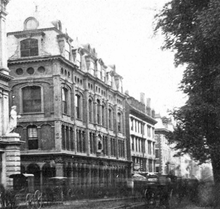
History
Artists' studios
From 1861 the Studio Building stood adjacent to the Horticultural Hall, on the opposite side of Bromfield St.[4] The building consisted of "a massive range of brick, four stories high, — the whole surmounted by a French roof; a handsome and imposing structure, in the lower story of which are six fine large stores, occupied [in 1869] by the Leavitt and Parker Sewing-Machine Cos., California Wine Agency, the Howard Clock Co., &c.; and, above-stairs, by numerous artists, painters, engravers, draughtsmen, &c."[6]
"The Studio Building ... is a perfect hive of artists. This building, indeed, is the headquarters of the artists of Boston. ... There are delightful artists' receptions here, to which the general public is invited. Besides the devotees of art, there are many private teachers of music and the languages in the Studio Building, and not a few of the rooms are occupied as bachelors' apartments."[7] Visitors included Sophia Peabody Hawthorne in 1863: "5 June, Thursday. Finest day - cool. We went out after breakfast with Annie. We visited Studio gallery - & saw good statue of Judge Shaw. Hunt's portrait by himself. Healy's Longfellow. Ames' Rachel. Gay's seashore & a pearly silvery sky of wondrous truth."[8]
Beginning in November 1861, artist William Rimmer gave anatomy "lectures in Room 55 of the Studio Building. He was an inspiring teacher; John LaFarge ... Daniel Chester French, Frederick Vinton, Frank Benson and many others testified to it. ... He represented the first thorough art instruction based on the human figure to be given in Boston, and indeed in the entire United States. ... Rimmer's lectures were never mere dry analyses of muscles and their attachments. He drew brilliantly on the blackboard, combining technical diagrams with fantastic embellishments. His figures sprouted wings, were set off by elegant draperies, sat beside elaborate urns, were clad in fanciful armor, brandished trumpets and daggers."[9] One of his students was May Alcott, who "studied sculpture with William Rimmer and painting with William Hunt at the new Studio Building in Boston, on the corner of Tremont and Broomfield streets."[10]
The "studio and gallery" of William Morris Hunt "were the great attractions to visitors who came to the 'receptions' given by the artists in the building. The stirring picture, The Bugle Call, painted in Newport, was exhibited here; the drawing of The Drummer Boy, which attracted great crowds while on exhibition in Messrs. Williams & Everett's window, was conceived and executed here. Its motto, 'To arms! To arms!' found a response in the mood of the citizens, who were burning with patriotic ardor. I think this was just after the firing upon Fort Sumter, in 1861."[11] According to one historian, however, Hunt himself probably found Boston "a far cry from the carefree vie de Boheme of Paris, and the life centering around the Studio Building on Tremont Street but a pale replica of the Latin Quarter -like a plaster cast, almost like a death mask, one might say, of the lively original."[12]
Tremont Theatre
"The new Tremont Theatre, in the Studio Building, on Tremont street, was remodelled from Allston Hall, and opened as a theatre on Feb. 9, 1863, under the management of Mrs. Jane English, with a ballet and pantomime troupe. ... For a brief period K. L. Davenport and J. W. Wallack were managers of the house, but notwithstanding the high character of the dramatic work done here, it was not a prosperous theatre. It was finally converted into a hall for pedestrian matches, and [by 1892 was] used for a retail carpet-store."[13]
Performances included:
- "Le Rue's great war show! The wonderful strato-pateticon, or walking-army"[14]
- Theatre Francais, directed by Paul Juignet, 1864-1865[15]
- Tom Taylor's The Ticket-of-Leave Man, 1865
- Holman Opera Troupe -Mr. George Holman, his wife, his daughter Sallie Holman (soprano/principal singer) and another daughter, and two sons, with some others, including William H. Crane and Sallie`s husband Mr. J. T. Dalton, which toured throughout Canada for many years.[16]
- Morris Brothers, Pell & Trowbridge's Minstrels
- Cotton & Murphy Minstrels[17]
Images
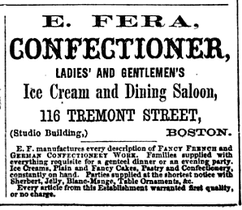 Advertisement for E. Fera's ice cream saloon, 1864
Advertisement for E. Fera's ice cream saloon, 1864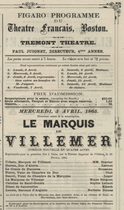 Detail of programme for Paul Juignet's Theatre Francais, 1865
Detail of programme for Paul Juignet's Theatre Francais, 1865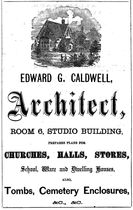 Advertisement for Edward G. Caldwell, architect, 1868
Advertisement for Edward G. Caldwell, architect, 1868 Advertisement for H.G. Smith, photographer, 1869
Advertisement for H.G. Smith, photographer, 1869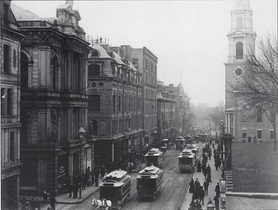 Tremont St., 1891, with view of Horticultural Hall, Studio Building (at left), Park St. Church, Granary Burying Ground (at right)
Tremont St., 1891, with view of Horticultural Hall, Studio Building (at left), Park St. Church, Granary Burying Ground (at right)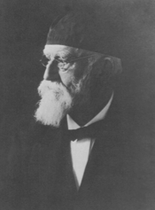 Portrait of Seth M. Vose, gallerist (photo 1900)
Portrait of Seth M. Vose, gallerist (photo 1900)
Tenants
- American Art Gallery[21]
- Joseph Ames[22][23]
- Miss M.K. Baker, artist[24][25]
- E.M. Bannister, artist[22]
- E.T. Billings, artist[26][27]
- Edward Brackett[28]
- Miss M.A. Bradford, artist[29]
- Mrs. E.H. Brainard, artist[30]
- Miss H.L. Brown, artist[26]
- J. Appleton Brown, artist[31]
- E.C. Cabot, architect[22]
- Edward G. Caldwell, architect[23]
- Miss E.M. Carpenter, artist[23]
- William Carl, artist[23]
- Miss A.E. Chandler, artist[32]
- F. Myron Clark[33]
- J.G. Cloudman, artist[22]
- George A. Clough, architect[23]
- Darius Cobb, artist[32][33]
- Theodore E. Colburn, architect[22]
- Henry Cook, artist[29]
- Charles Copeland, artist[27]
- J.C. Crossman, artist[22][23]
- George L. Crosby, artist[32]
- Cummings & Sears, architects[22][23][34]
- Cyrus E. Dallin, artist[35]
- Thomas W. Dewing, artist[36]
- T.C. Doane[23]
- John Donoghue, artist[37]
- Morris Dorr, architect[22][23]
- Grace Dow, artist[37]
- Frank Duveneck, artist[38]
- B.F. Dwight, architect[22][23]
- Educational Committee for Freedmen[22]
- L.D. Eldred, artist[25]
- William R. Emerson, architect[22]
- Miss M.M. Emery, artist[25]
- Fabronius, artist[36]
- A.C. Fenety, artist[25]
- F.M. Fenety, artist[25]
- Beatrice V. Folsom, artist[27]
- Bradford Freeman, artist[39]
- Francis Seth Frost[40]
- Edmund H. Garrett, artist[33][41]
- Ignaz Gaugengigl, artist[42][43][44]
- S.L. Gerry[23]
- Ellen L. Gilbert, artist, educator[45][46]
- James Gilbert, artist[25]
- Abbott Graves[43]
- James R. Gregerson, architect[22]
- S.W. Griggs, artist[23][44]
- Louis K. Harlow, artist[43]
- George F. Higgins, artist[25]
- S.P. Hodgdon, artist[22][23]
- Mrs. Horton, artist[22]
- William Morris Hunt
- Phoebe A. Jenks, artist[44][47]
- N.T. Johnson, artist[23]
- D.C. Johnston and T.M.J. Johnston, artists[22]
- Earnest Kuhn, artist[22][23]
- Walter F. Lansil, artist[27][43]
- A.W. Latham, artist[25]
- Edmonia Lewis[28]
- L.K. Long, artist[25]
- W.P.P. Longfellow, architect[22][23]
- G.A. Loring, artist[27]
- Miss E.P. Mann, artist[25]
- Marshall & Co., photographs[22]
- Mrs. M.C. McGurk, artist[27]
- H.W. Merrill, artist[23]
- Samuel S. Miles, artist[27]
- Martin Millmore, sculptor[22][48][49]
- B.R. Morse, artist[32]
- George C. Munzig, artist[32]
- P. Nefflen, artist[22]
- New England Loyal Publication Society (related to the Loyal Publication Society[22][50]
- Jessie Noa, artist[25]
- F. Evelyn Nute, artist[44]
- Alfred Ordway, artist[42][51]
- H. Winthrop Peirce, artist[43][46]
- S.E. Perkins, artist[52]
- Miss M.A. Platt, artist[27]
- B.C. Porter, artist[23][32]
- C.W. Reed, artist[23]
- Miss H. Reed, artist[32]
- Mrs. E.S. Remick, artist[27]
- J.F. Reynolds[33]
- William Rimmer, sculptor[36]
- Thomas Robinson, artist[23][42]
- S.W. Rowse, artist[22]
- L.A. Schirmer, artist[32]
- G.W. Seavey, artist[52]
- Frank H. Shapleigh, artist[52]
- Anna H. Silloway, artist[25]
- T.S. Slafter, artist[25]
- H.G. Smith, photographer, publisher[53][54]
- George Snell, architect[22][55][56]
- Miss Southwick, artist[22]
- Charles E. Stetfield, artist[23]
- Miss S.C. Stetson, artist[22][23]
- Frederick T. Stuart, artist, c. 1902[41]
- Miss F.W. Tewskbury, artist[25]
- Jerome Thompson, painter[57]
- John D. Towle & Son, architects[23]
- Henry Van Brunt and William Robert Ware, architects[22]
- Herman Vogel, artist[44]
- Seth Morton Vose, gallerist[58][38]
- Lilian Walker, artist[27]
- Florence I. Webber, artist[27]
- George A. Weeden, artist[27]
- Fred D. Williams, artist[22][23]
- Joseph P. Woodbury, "inventor"[22]
- Elizabeth Wyer, artist[25]
References
- The Crayon, Vol. 8, No. 2 (Feb., 1861)
- Studio Building, no.112 Tremont St.; cf. Boston Directory. 1862
- Studio Building no.110 Tremont St; cf. Boston Almanac, 1865, 1894
- Mann. Walks & talks about historic Boston. The Mann publishing co., 1917
- New England Magazine, Feb. 1907
- Stranger's new guide through Boston and vicinity. Boston: A. Williams, 1869. Google books
- Boston Illustrated. Boston: James R. Osgood & Co., 1872
- Thomas Woodson, James A. Rubino, Jamie Barlowe Kayes. With Hawthorne in Wartime Concord: Sophia Hawthorne's 1862 Diary. Studies in the American Renaissance, (1988)
- Lincoln Kirstein. William Rimmer: His Life and Art. Massachusetts Review, Vol. 2, No. 4 (Summer, 1961)
- April F. Masten. Art Work: Women Artists and Democracy in mid-Nineteenth-Century New York. University of Pennsylvania Press, 2008; p.283
- Frederic P. Vinton. William Morris Hunt: Personal Reminiscences. American Art Review, Vol. 1, No. 2 (Dec., 1879)
- Albert Ten Eyck Gardner. A Rebel in Patagonia. Metropolitan Museum of Art Bulletin, New Series, Vol. 3, No. 9 (May, 1945)
- Bacon. Boston of to-day: a glance at its history and characteristics. Post Publishing Company, 1892
- Hartford Daily Courant, May 5, 1864
- American Broadsides and Ephemera, Series 1
- Morgan, Henry James, ed. (1903). Types of Canadian Women and of Women who are or have been Connected with Canada. Toronto: Williams Briggs. p. 161.
- Winsor. The memorial history of Boston: including Suffolk County, Massachusetts, 1630-1880, Volume 4. Boston: James R. Osgood, 1886. Google books
- Fire loss at Boston, business heart of the city threatened for a time; loss $150,000. Ft. Worth Telegram, Dec. 19, 1906
- Artists robbed after fire: some pictures stolen, others perforated, in Boston Studios. New York Times, Dec. 21, 1906
- Heavy damage by fire in Boston: great destruction on Tremont Street was threatened. Columbus Enquirer Sun (Georgia), 1906
- New York Times, March 22, 1880
- Boston Almanac, 1865. Retrieved 2010-09-30.
- Boston Directory, 1868.
- Boston Almanac. 1875, 1888
- Boston Almanac, 1889. Retrieved 2010-09-30.
- Boston Almanac. 1865, 1875, 1888, 1889
- Boston Almanac, 1894. Retrieved 2010-09-30.
- Marilyn Richardson. "Hiawatha in Rome: Edmonia Lewis and Figures from Longfellow". Antiques & Fine Arts.
- Boston Almanac. 1888, 1889, 1894
- Boston Almanac. 1888, 1889
- Frank Torrey Robinson. Living New England artists: biographical sketches, reproductions of original drawings and paintings by each artist. Boston: S. E. Cassino, 1888
- Boston Almanac, 1876. Retrieved 2010-09-30.
- New York Times, Dec. 21, 1906
- Boston commercial directory for 1869
- William Howe Downs. Cyrus E. Dallin, Sculptor. Brush and Pencil, Vol. 5, No. 1 (Oct., 1899)
- Susan Hobbs. Thomas Wilmer Dewing: The Early Years, 1851-1885. American Art Journal, Vol. 13, No. 2 (Spring, 1981)
- Boston Almanac. 1888
- Robert C. Vose, Jr. and Robert F. Brown. Boston's Vose Galleries: A Family Affair. Archives of American Art Journal, Vol. 21, No. 1 (1981)
- New Hampshire Historical Society
- Boston Directory. 1864
- 8th Annual exhibition of paintings by prominent artists at the Poland Spring Art Gallery. Maine: H. Ricker & sons, 1902
- Catalogue of the third annual exhibition of the Paint and Clay Club: held at the Gallery of the Boston Art Club, March 1884. Cambridge: Riverside Press, 1884
- Robinson. 1888
- Boston Almanac. 1889, 1894
- American Art Notes. American Art Illustrated, Vol. 1, No. 1 (Oct., 1886)
- Boston Almanac. 1889
- "Phoebe Pickering Jenks." Robinson. 1888
- Letter from Wendell Phillips to W.R. Emerson, Sept. 8, 1872; cf. Irving H. Bartlett and Emerson. The Philosopher and the Activist: New Letters from Emerson to Wendell Phillips. New England Quarterly, Vol. 62, No. 2 (Jun., 1989)
- Boston Directory. 1873
- William Endicott. Tribute to Professor Norton. Proceedings of the Massachusetts Historical Society, Third Series, Vol. 2, 1908
- Boston Almanac. 1865, 1889, 1894
- Boston Almanac. 1875, 1889, 1894
- Advertisement detail of: "Nanitz' great mercantile map of Boston" (Boston: B.B. Russell, 1869)
- Illuminated business directory of Boston, 1870
- Obituary notes. New York Times, Feb. 24, 1893
- Maud Howe Elliott. Artists I Have Known through Eighty Years. North American Review, Vol. 248, No. 2 (Winter, 1939/1940)
- Boston Daily Evening Transcript - Aug 19, 1868
- Obituary: Seth Morton Vose. American Art News, Vol. 8, No. 26 (Apr. 9, 1910), p. 7
External links
| Wikimedia Commons has media related to Studio Building, Boston (Tremont Street). |
- Flickr. Portrait of Theadoria Caffrain Homes, 1860s; by Marshall, photographer, Studio Building, Cor. Tremont & Bromfield Sts., Boston
- Historic New England. Drawing of Studio Building
- Boston Athenaeum. James Wells Champney's "Sketch from Studio Building, Boston, during fire. 4 o’clock morning Nov. 10th, 1872"
- Bostonian Society. Photo of Studio Building at 104-116 Tremont Street, 1905
- Boston Public Library. Photo, 1916